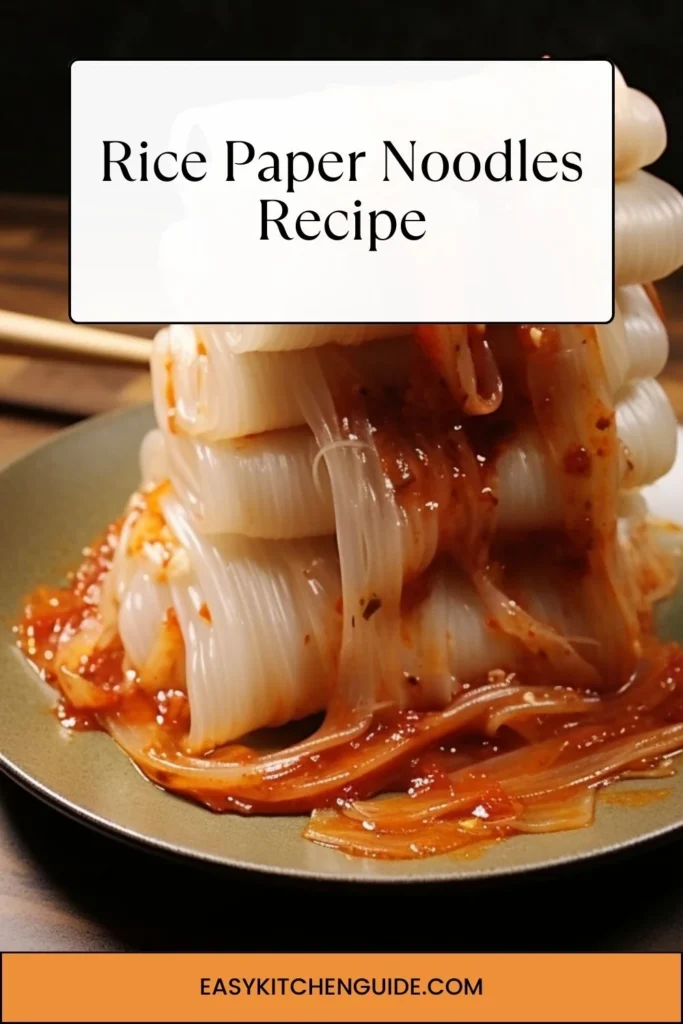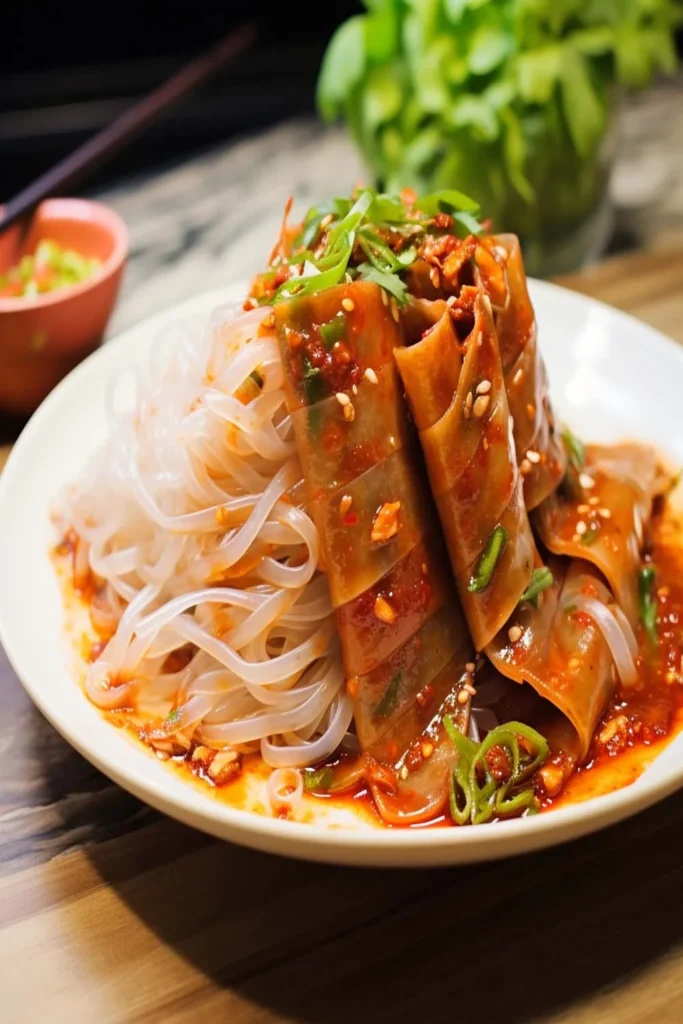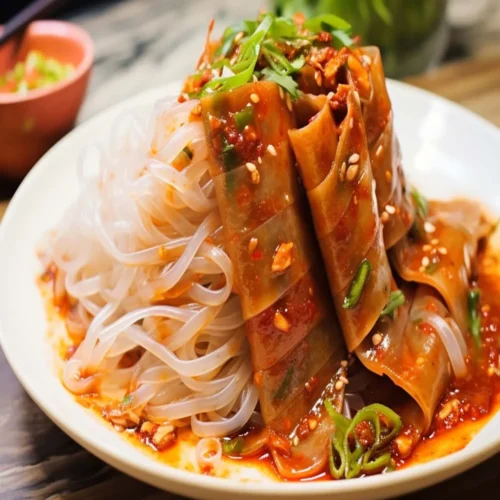Rice paper noodles, also known as cellophane noodles, glass noodles, and bean thread noodles, are a type of noodle made from the starch of mung beans, yams, or potatoes.
Rice paper noodles are a staple in many Asian cuisines and can be found in dishes from China, Japan, Thailand, and Vietnam. The noodles are thin, translucent, and chewy, and they absorb the flavors of the ingredients they are cooked with.

What is Rice Paper Noodles?
Rice paper noodles are a versatile ingredient that can be used in a variety of recipes. They can be added to soups, stir-fries, salads, and more.
They are often used as a base for noodle dishes, and they can also be used as a wrap for dumplings or spring rolls. Rice paper noodles can be cooked quickly and can be enjoyed hot or cold.
What Does It Taste Like?
Rice paper noodles have a mild flavor and a chewy texture. The noodles absorb the flavors of the ingredients they are cooked with, so they can take on a variety of flavors depending on how they are prepared.
The noodles can be stir-fried with vegetables and sauces or added to soups and salads.
You’ll also like the following Dinner recipes!
Ingredients
Base Ingredients:
- 20 rice paper sheets (around 22cm wide): Rice paper sheets serve as the wrapper for the noodles, providing a light and delicate texture. They need to be softened with warm water before rolling to make them pliable.
- 2 teaspoons oil for greasing: Oil is used to grease the sheets, preventing them from sticking together and facilitating the rolling process.
- Warm water for your large bowl: Warm water is needed to soften the rice paper sheets before assembling the noodles. This allows for easy handling and rolling.
Optional Ingredients For Dish:
- 2 teaspoons oil for cooking garlic: Oil for cooking garlic adds a savory and aromatic flavor to the dish, enhancing the overall taste.
- 4 heads baby bok choy: Baby bok choy adds a mild and fresh green flavor, as well as a crisp texture to the noodles.
- 4 cloves garlic, minced (around 2-4 teaspoons minced garlic): Minced garlic provides a pungent and savory taste, complementing the other ingredients in the dish.
- 2 teaspoons roasted sesame oil: Roasted sesame oil adds a rich and nutty flavor, contributing depth and enhancing the overall aroma of the noodles.
- 2 tablespoons soy sauce: Soy sauce is a key seasoning, providing a salty and savory taste to the noodles.
- 4 stalks green onion, chopped: Chopped green onions add freshness, a mild onion flavor, and a vibrant color to the dish.
- 2 tablespoons dark soy sauce: Dark soy sauce adds depth of color and a slightly sweet and richer flavor to the noodles.
- 1 teaspoon sesame seeds: Sesame seeds provide a crunchy texture and nutty taste, enhancing the overall mouthfeel and flavor of the noodles.
- 2 teaspoons sugar: Sugar adds a touch of sweetness, balancing the saltiness and enhancing the overall flavor profile of the dish.

Directions
Step 1: Prepare Rice Paper Noodles:
- Fill a large bowl with warm water.
- Dip each rice paper sheet into the warm water for a few seconds until it becomes pliable.
- Place it on a clean surface.
Step 2: Assemble Rice Paper Noodles:
- In the center of each rice paper sheet, place a few rice noodles.
- Fold the sides over the noodles and then roll tightly from the bottom to form a roll.
- Repeat for all the rice paper sheets.
Step 3: Grease and Arrange:
- Lightly grease a plate or tray with oil to prevent the rice paper noodles from sticking.
- Place the assembled rolls on the plate or tray.
Step 4: Prepare Optional Ingredients:
- Heat oil in a pan and sauté minced garlic until fragrant.
- Add baby bok choy, soy sauce, dark soy sauce, sugar, and sesame oil.
- Cook until the bok choy is tender-crisp.
Step 5: Serve:
- Arrange the rice paper noodles on a serving plate.
- If desired, top the rolls with the sautéed baby bok choy.
- Sprinkle with chopped green onions and sesame seeds.
Step 6: Enjoy:
- Serve the rice paper noodles with the optional ingredients as a light and refreshing meal.
- Drizzle extra soy sauce or your favorite dipping sauce for added flavor.
- These rice paper noodles are perfect for a quick and healthy lunch or dinner.
Tips
– To give the noodles more flavor, add a tablespoon of sesame oil or chili oil to the pan before adding the vegetables.
– For an extra kick of flavor, add a tablespoon of freshly grated ginger or garlic to the pan when stir-frying the vegetables.
– To make the dish spicier, add a teaspoon of chili flakes or a teaspoon of chili paste to the pan when adding the sauce.
– To give the noodles a more chewy texture, add a tablespoon of cornstarch or arrowroot starch to the pan when adding the sauce.
– To give the noodles a crunchy texture, add a tablespoon of toasted sesame seeds to the pan when adding the sauce.

Nutrition Information
Rice paper noodles are a good source of carbohydrates and fiber. They are low in fat and contain no cholesterol. One serving (100g) of cooked rice paper noodles contains:
– Calories: 300
– Fat: 0g
– Carbohydrates: 40g
– Protein: 6g
– Fiber: 3g
What to Serve with Rice Paper Noodles?
- Rice paper noodles can be served with a variety of dishes. Here are some suggestions:
- Stir-fried vegetables: Rice paper noodles can be served with a variety of stir-fried vegetables. Common vegetables that pair well with the noodles include carrots, bell peppers, onions, mushrooms, and snow peas.
- Soups: Rice paper noodles can be added to soups to give them a chewy texture. Common soups that pair well with the noodles include miso soup, tom yum soup, and wonton soup.
- Salads: Rice paper noodles can be added to salads to give them a chewy texture. Common salads that pair well with the noodles include Vietnamese noodle salads, Thai noodle salads, and Chinese noodle salads.
- Spring rolls: Rice paper noodles can be used as a wrap for spring rolls. The noodles give the spring rolls a chewy texture and add a burst of flavor.
- Fried rice: Rice paper noodles can be added to fried rice to give it a chewy texture.
How to Store Leftover Rice Paper Noodles?
Leftover rice paper noodles can be stored in an airtight container in the refrigerator for up to 3 days. To reheat, add the noodles to a skillet with a tablespoon of oil and cook over medium heat until heated through.
What Other Substitutes Can I Use in Rice Paper Noodles?
If you don’t have rice paper noodles, there are several other ingredients that can be used as substitutes. Here are some suggestions:
- Kelp noodles: Kelp noodles are made from the stalks of seaweed and have a chewy texture similar to rice paper noodles.
- Soba noodles: Soba noodles are made from buckwheat and have a nutty flavor and a chewy texture.
- Udon noodles: Udon noodles are made from wheat flour and have a chewy texture similar to rice paper noodles.
- Vermicelli noodles: Vermicelli noodles are made from rice flour and have a similar texture to rice paper noodles.
- Rice noodles: Rice noodles are made from rice flour and have a chewy texture similar to rice paper noodles.

Rice Paper Noodles Recipe
Equipment
- bowl
- Cutting knife
Ingredients
Base Ingredients:
- 20 rice paper sheets around 22cm wide
- 2 teaspoons oil for greasing
- Warm water for your large bowl
Instructions
Prepare Rice Paper Noodles:
- Fill a large bowl with warm water. Dip each rice paper sheet into the warm water for a few seconds until it becomes pliable. Place it on a clean surface.
Assemble Rice Paper Noodles:
- In the center of each rice paper sheet, place a few rice noodles. Fold the sides over the noodles and then roll tightly from the bottom to form a roll. Repeat for all the rice paper sheets.
Grease and Arrange:
- Lightly grease a plate or tray with oil to prevent the rice paper noodles from sticking. Place the assembled rolls on the plate or tray.
Prepare Optional Ingredients:
- Heat oil in a pan and sauté minced garlic until fragrant. Add baby bok choy, soy sauce, dark soy sauce, sugar, and sesame oil. Cook until the bok choy is tender-crisp.
Serve:
- Arrange the rice paper noodles on a serving plate. If desired, top the rolls with the sautéed baby bok choy and sprinkle with chopped green onions and sesame seeds.
Enjoy:
- Serve the rice paper noodles with the optional ingredients as a light and refreshing meal. Drizzle extra soy sauce or your favorite dipping sauce for added flavor. These rice paper noodles are perfect for a quick and healthy lunch or dinner.
Notes
- To give the noodles more flavor, add a tablespoon of sesame oil or chili oil to the pan before adding the vegetables.
- For an extra kick of flavor, add a tablespoon of freshly grated ginger or garlic to the pan when stir-frying the vegetables.
- To make the dish spicier, add a teaspoon of chili flakes or a teaspoon of chili paste to the pan when adding the sauce.
- To give the noodles a more chewy texture, add a tablespoon of cornstarch or arrowroot starch to the pan when adding the sauce.
- To give the noodles a crunchy texture, add a tablespoon of toasted sesame seeds to the pan when adding the sauce.
Frequently Asked Questions
Q1. What are rice paper noodles?
A1. Rice paper noodles are a type of noodle made from the starch of mung beans, yams, or potatoes. They are thin, translucent, and chewy, and they absorb the flavors of the ingredients they are cooked with.
Q2. What does rice paper noodles taste like?
A2. Rice paper noodles have a mild flavor and a chewy texture. The noodles absorb the flavors of the ingredients they are cooked with, so they can take on a variety of flavors depending on how they are prepared.
Q3. How do you cook rice paper noodles?
A3. Rice paper noodles can be cooked quickly and can be enjoyed hot or cold. To prepare the noodles, place them in a large bowl and cover with warm water. Let the noodles soak for 10 minutes, or until they are soft and pliable. Once the noodles have softened, drain them and set aside. The noodles can then be added to soups, stir-fries, salads, and more.
Q4. What are some substitutes for rice paper noodles?
A4. If you don’t have rice paper noodles, there are several other ingredients that can be used as substitutes. These include kelp noodles, soba noodles, udon noodles, vermicelli noodles, and rice noodles.
Q5. How long do rice paper noodles last?
A5. Leftover rice paper noodles can be stored in an airtight container in the refrigerator for up to 3 days. To reheat, add the noodles to a skillet with a tablespoon of oil and cook over medium heat until heated through.
Q6. What do you serve with rice paper noodles?
A6. Rice paper noodles can be served with a variety of dishes. These include stir-fried vegetables, soups, salads, spring rolls, and fried rice.
Q7. What is the nutrition information for rice paper noodles?
A7. Rice paper noodles are a nutritious option, with a 100g serving containing 200 calories, 0g of fat, 40g of carbohydrates, 6g of protein, and 3g of fiber.
Conclusion
Rice paper noodles are a versatile and gluten-free option that adds a delightful texture to a variety of dishes. Whether you’re creating fresh spring rolls, a flavorful noodle salad, or a hot stir-fry, these noodles provide a light and satisfying base.
With their ease of preparation and compatibility with different flavors, rice paper noodles are a great addition to your culinary repertoire. Enjoy experimenting with these noodles to create delicious and healthy meals!
You’ll also like the latest recipes!
- Copycat Spicy Noodle Spring Rolls
- Fruit Roll Up Ice Copycat Cream
- How to Make Gochujang Garlic Bread
My name is Lori Walker. I’m a registered dietitian, food blogger and food enthusiast. I share easy healthy, delicious recipes on my blog and review necessary kitchen items. The recipes I share take less… Read more
